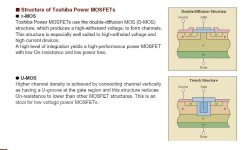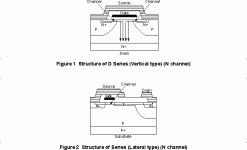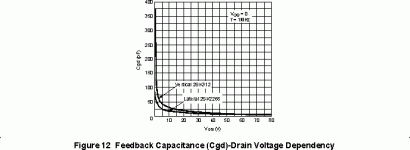Terry Demol said:
So I take it you have done listening tests with single versus
multiple OP devices of same type same amp etc?
Cheers,
Terry
i wont lie to u , i never added more output trannies to a working amp .
but ...i've tested some amps with many output pairs VS amps with one pair (different trannies) .
i'm always trying to make an ideal amp that will just amplify the signal ...without adding things to the signal (valves etc...)
from what i can tell multiple output stage always got lower output impedance and its less prone to oscilate .
i see no advantage in single output pair over multiple pairs 🙄 (when theres no money involved)
EUVL said:
Does Semelab offer them directly ?
Would you have a part number for an 2SK1058 equivalent, for example
It would be the ECX10N16 from Exicon
http://www.profusionplc.com/cgi-bin/gex/pcatdtl?ipartno=ECX10N16
Here's the equivalent chart for hitachi types
http://www.profusionplc.com/hitachi.htm
You can buy the Exicons online from Profusion.
EUVL said:> The 2SK1529 is a vertical MOSFET from Toshiba.
According to Toshiba, they call it pi-MOS. And it looks more like lateral than vertical to me. See my previous post :
http://www.diyaudio.com/forums/showthread.php?postid=661146#post661146
Also the Ciss is much lower than e.g. an IRFP240 :
IRFP240 1300p
2SK1529 700p
2SK1058 600p
Toshiba doesn't say, but in the US we have a saying, "If it walks like a duck and quacks like a duck, then it is a duck."
Lateral power parts can be distinguished from vertical power parts by the following:
1) Gate threshold voltage is less than 1 volt for lateral parts and over 2 volts for vertical parts.
2) Lateral parts have the source tied to the case, while vertical parts have the drain tied to the case. (For flat plastic cases, the middle lead is tied to the case.)
3) The zero tempco point is well under 1 amp for lateral devices and well over 1 amp for vertical devices.
4) The input capacitance (specifically Crss = Cgd) is much lower for lateral parts than comparable vertical parts.
5) The transconductance is significantly higher for vertical parts than for comparable lateral parts.
The Hitachis are lateral parts, as noted in their literature. The Toshibas are not specified, but can be identified as verticals by the above noted characteristics. The Toshibas are the only vertical MOSFETs that are designed for audio with true complements available.
Hi,
it's funny to see the often returned topic wether a FET is a vertical o horizontal/lateral with refferings to speces from datasheets while the name "veritcal" and "horizontal/lateral" is merely just a naming after the process, eg. more exactely how the channel layout in the silicon die is physically situated, correct me if I'm wrong.
I also agree with Charles, by looking at the datasheet the Toshiba's reminds more to be verticals.
EDIT: Does anybody know a cheap source for Toshibas?
Cheers Michael
it's funny to see the often returned topic wether a FET is a vertical o horizontal/lateral with refferings to speces from datasheets while the name "veritcal" and "horizontal/lateral" is merely just a naming after the process, eg. more exactely how the channel layout in the silicon die is physically situated, correct me if I'm wrong.
I also agree with Charles, by looking at the datasheet the Toshiba's reminds more to be verticals.
EDIT: Does anybody know a cheap source for Toshibas?
Cheers Michael
i've read a review (long time ago) that described the nap500 as being internally bridged:2 amplifiers per channel.
sss said:
next thing they gonna say is "we are using one big cap on the power supply , rather then many small ones 🙄 "
Have you ever seen the inside of a naim amp? They do use big cap instead of small ones!!
They use 2x 22,000uf caps to be precise in many of their power amps and also in the hicap/supercap preamp power supplies
On the Nature of Ducks
I see that you are trying to argue that a bird that walks like a duck and quacks like a duck is actually *not* a duck. Please compare the diagrams below and you will see that it actually is a duck.
EUVL said:Their U-MOS looks more like the IRF Mosfets to me.
I see that you are trying to argue that a bird that walks like a duck and quacks like a duck is actually *not* a duck. Please compare the diagrams below and you will see that it actually is a duck.
Attachments
A Short Treatise on the Characteristics of Ducks
For those of you who are fans of vertical MOSFETs, it may be instructive to look at the figure showing Cgd for the two types of MOSFETs. (Cgd is the important parameter for followers, which are the main circuit used for these devices in audio power amplifiers.)
Note that the capacitance increases by a factor of four for the lateral part between Vds = 10 and Vds = 0. For the vertical part, the capacitance increases by a factor of roughly ten. However this diagram is severely understating the problem, as you will note that the test conditions are Vgs = 0. This, of course, is not how these parts are used.
To get a better idea of how the curves are in real life, you must shift them to the right by the threshold voltage. In the case of the lateral part this is approximately 1 volt, and for the vertical part this is approximately 4 volts.
Now you must ask yourself what happens as Vds continues to 0 volts (as it does when driving the amplifier to full output). In this case the vertical part continues its precipitous rise in Cgd, while the lateral part simply levels off with no further increase in Cgd. So in real life the non-linearity in Cgd is about 10x worse for vertical parts.
For those of you who are fans of vertical MOSFETs, it may be instructive to look at the figure showing Cgd for the two types of MOSFETs. (Cgd is the important parameter for followers, which are the main circuit used for these devices in audio power amplifiers.)
Note that the capacitance increases by a factor of four for the lateral part between Vds = 10 and Vds = 0. For the vertical part, the capacitance increases by a factor of roughly ten. However this diagram is severely understating the problem, as you will note that the test conditions are Vgs = 0. This, of course, is not how these parts are used.
To get a better idea of how the curves are in real life, you must shift them to the right by the threshold voltage. In the case of the lateral part this is approximately 1 volt, and for the vertical part this is approximately 4 volts.
Now you must ask yourself what happens as Vds continues to 0 volts (as it does when driving the amplifier to full output). In this case the vertical part continues its precipitous rise in Cgd, while the lateral part simply levels off with no further increase in Cgd. So in real life the non-linearity in Cgd is about 10x worse for vertical parts.
Attachments
You must make " heavy duty " driver a low value gate stoper, Charles.... I have 39 R and distortion is around.001 %...
My preference is for simple circuits. There are two nice advantages to lateral MOSFETs compared to bipolars -- they don't need a driver stage and they don't need thermal tracking for the bias circuit. Both of these advantages disappear for vertical MOSFETs.
I also prefer to make circuits that are inherently linear, instead of making a non-linear circuit and then trying to correct the non-linearities with feedback.
I also prefer to make circuits that are inherently linear, instead of making a non-linear circuit and then trying to correct the non-linearities with feedback.
I know your products, Charles... At first listening they sounded interesting, but by attentive listening I hear distortion at peaks ( not by clipping 😉 ), but be calm, by listening of NP's ones, I hear it also.... Low feedback and simplicity isn't universal medicine...
Hmm. I don't hear that with our current products. The original V-3 amplifier (now discontinued for nearly 6 years) could exhibit that problem in some situations, due to its use of vertical MOSFETs in the output stage.
By the way, others don't hear that either. Hi Fi Choice has just awarded the K-1 and V-1 a Gold Award in the category of best preamp and amplifier over £ 5000.00. Silver award went to the Naim NAC 552 / NAP 500 and the Bronze award went to the Burmester 011 / 911 Mk 3. This was especially nice for us, seeing as how these competing products cost 2 - 3 times as much as the Ayre gear (at least here in the US).
By the way, others don't hear that either. Hi Fi Choice has just awarded the K-1 and V-1 a Gold Award in the category of best preamp and amplifier over £ 5000.00. Silver award went to the Naim NAC 552 / NAP 500 and the Bronze award went to the Burmester 011 / 911 Mk 3. This was especially nice for us, seeing as how these competing products cost 2 - 3 times as much as the Ayre gear (at least here in the US).
I have heard more of your amps with the same problems, Charles and I wasn't alone...but I have extremly high claims... 😉
Agisthos said:
Have you ever seen the inside of a naim amp? They do use big cap instead of small ones!!
They use 2x 22,000uf caps to be precise in many of their power amps and also in the hicap/supercap preamp power supplies
😀 😀
What is so funny about that?
The bigger Naim amps use big caps (no bridge rectifiers) AND regulators with fast and reasonable small caps following.
The smaller amps use smaller caps (channel separated).
The HiCap/SuperCap etc. preamp psus are using big caps AND lots of regulators.
So I ask you: What is wrong with that concept? I find it very clear and the differences can be very easy audibly verified.
I suppose all people who are mocking about Naim amps have neither heard them nor used them for an extended period. If they are too expensive for you, do not buy them.
I also think they definitely are expensive (yes, the NAP500 is simply too expensive), and this is the same with Ayre and Passlabs, but there is for sure a good reason or many for that. Prices are also a question of markets and marketing. But this is a DIY forum, so price discussions of final products are a waste of space.
The bigger Naim amps use big caps (no bridge rectifiers) AND regulators with fast and reasonable small caps following.
The smaller amps use smaller caps (channel separated).
The HiCap/SuperCap etc. preamp psus are using big caps AND lots of regulators.
So I ask you: What is wrong with that concept? I find it very clear and the differences can be very easy audibly verified.
I suppose all people who are mocking about Naim amps have neither heard them nor used them for an extended period. If they are too expensive for you, do not buy them.
I also think they definitely are expensive (yes, the NAP500 is simply too expensive), and this is the same with Ayre and Passlabs, but there is for sure a good reason or many for that. Prices are also a question of markets and marketing. But this is a DIY forum, so price discussions of final products are a waste of space.
Naim amps have a renowned reputation for speed and PRAT.
The fact they use only a pair of output transistors instead of many in parallel, the fact they use a pair of big caps instead of many small ones - this all probably contributes to the trademark sound of their amps and their design approach should not be dismissed.
The fact they use only a pair of output transistors instead of many in parallel, the fact they use a pair of big caps instead of many small ones - this all probably contributes to the trademark sound of their amps and their design approach should not be dismissed.
EDIT: Does anybody know a cheap source for Toshibas?
Hi Ultima Thule,
try http://pacificsemi.com. I have never used them but Hugh of Aksa I think recommends them.
good luck.
Hi Luke,
Ah, not these guys - they are in Canada and quite a bit dearer!!
Try
http://www.peacock.com.sg
Cheers,
Hugh
Ah, not these guys - they are in Canada and quite a bit dearer!!
Try
http://www.peacock.com.sg
Cheers,
Hugh
- Status
- Not open for further replies.
- Home
- Amplifiers
- Solid State
- New Naim Output Transistors


